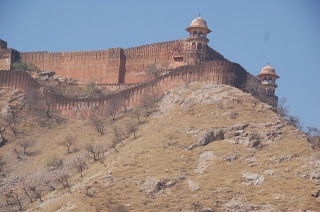Mont Saint Michel is an islet just off the coast of France, where the Couesnon River flows into the sea. This river has always been touted as the border between Brittany and Normandy. However, the flow of the river has changed from time to time and the Mont is now in Normandy.
In prehistoric times this area was all land. But the scouring of the sea over eons has removed the softer rocks leaving this hunk of granite.The natural shape of the islet served several different peoples as guardian fortresss over the centuries. Following the departure of the Romans in 460 AD, the Mont was held by the Amoricans, a Romano-Breton culture which extended into Britain. But it was conquered by the Franks. The origin of the monastery on the peak of the Mont is told in a very colorful legend. Supposedly the Archangel Michael appeared to St. Aubert, bishop of nearby Avranches in 708 AD, telling him to build a church on the islet. St. Aubert ignored him several times until reportedly the Archangel burned a hole in his skull with his finger. The church was built and eventually did become a monastery.
In the above portion, at the right upper corner, the Mont is pictured in the famous Bayeaux Tapestry showing the conquest of Normandy by William in 1066. The monastery gave its support to William of Normandy in 1067 in his bid for the throne of England. Four centuries later after many changes in the relationship of England and France, England put the Mont to siege in 1423-24 but failed to conquer it. The monastery and its wealth and holdings were great for the next 4 centuries. But with the French Revolution, its influence faded. The French then made it into a prison. Many of the remains of that prison are still seen in the monastery buildings at the peak of the islet. Among the remains is a large wheel shaped cage in which 4 prisoners would run like hamsters to power a hoist that would bring supplies from the sea up to the prison at the peak. The prison was closed in 1863 and gradually Mont Saint Michel attained its proper historical importance when it was made a historic monument in 1874. In 1979 it was declared a UNESCO World Heritage site.
The islet has been connected to the mainland by a bridge of land at low tide which was obliterated at high tide. The bay silted up due to the lack of water motion in and around the Mont and also due to the grazing of sheep on the salt flats. In 1879 the land bridge was built up into a permanent causeway. One could drive out to a parking area to visit the islet. But it was thought that this was not historical and it was felt that the natural water motion in the area should be restored. Therefore a hydraulic dam was built across the River Couesnon and the causeway was obliterated starting in 2009 (after we were there). This project will be completed in 2012. There will now be a foot bridge to the Mont, and shuttles will take people from a parking lot on the mainland to visit the site.
I found Mont Saint Michel to be very quaint. Climbing through the spiralling streets from the sea level to the Monastery at the peak, creates a sense of returning to Medieval times. One can easily picture what life was like here in centuries past. That's one of the attractions to travel: the sense of history and identifying with and learning from what came before.































